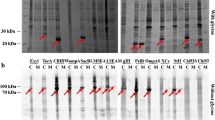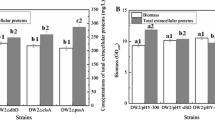Abstract
Two genes, ctc and ctc2, responsible for surface layer (S-layer) protein synthesis in Bacillus thuringiensis CTC, were mutated and resulted in B. thuringiensis Tr5. To synthesize and express the N-acyl-homoserine lactonase (AHL-lactonase) in the extracellular space of B. thuringiensis, the aiiA 4Q7 gene (an AHL-lactonase gene from B. thuringiensis 4Q7), which confers the ability to inhibit plant soft rot disease in B. thuringiensis 4Q7, was fused with the upstream sequence of the ctc gene, which in turn is essential for S-layer protein secretion and anchoring on the cell surface. The resulting fusion gene, slh-aiiA, was expressed in B. thuringiensis Tr5 to avoid competition for the extracellular space with the native S-layer protein. Our results indicate that B. thuringiensis Tr5 containing the fusion gene slh-aiiA displayed high extracellular AHL-degrading activity. When compared with wild-type B. thuringiensis strains, the ability of the constructed strain to inhibit soft rot disease caused by Erwinia carotovora SCG1 was markedly increased. These findings provide evidence for a significant advance in our ability to inhibit soft rot disease caused by E. carotovora.





Similar content being viewed by others
References
Arantes O, Lereclus D (1991) Construction of cloning vectors for Bacillus thuringiensis. Gene 108:115–119
Bassler BL (1999) How bacteria talk to each other: regulation of gene expression by quorum sensing. Curr Opin Microbiol 2:582–587
Bradford MM (1976) A rapid and sensitive method for the quantitation of microgram quantities of protein utilizing the principle of protein-dye binding. Anal Biochem 72:248–254
Byers JT, Lucas C, Salmond GPC, Welch M (2002) Nonenzymatic turnover of an Erwinia carotovora quorum-sensing signaling molecule. J Bacteriol 184:1163–1171
Dong YH, Xu JL, Li XZ, Zhang LH (2000) AiiA, an enzyme that inactivates the acylhomoserine lactone quorum-sensing signal and attenuates the virulence of Erwinia carotovora. Proc Natl Acad Sci USA 97:3526–3531
Dong YH, Wang LH, Xu JL, Zhang HB, Zhang XF, Zhang LH (2001) Quenching quorum sensing-dependent bacterial infection by an N-acyl homoserine lactonase. Nature 411:813–817
Dong YH, Gusti AR, Zhang Q, Xu JL, Zhang LH (2002) Identification of Quorum-Quenching N-acyl homoserine lactonases from Bacillus species. Appl Environ Microbiol 68:1754–1759
Espinasse S, Gohar M, Lereclus D, Sanchis V (2004) An extracytoplasmic-function sigma factor is involved in a pathway controlling beta-exotoxin I production in Bacillus thuringiensis subsp. thuringiensis strain 407-1. J Bacteriol 186:3108–3116
Fuqua C, Winans SC, Greenberg EP (1996) Census and consensus in bacterial ecosystem: the luxR-luxI family of quorum-sensing transcriptional regulaters. Annu Rev Microbiol 50:727–751
Juárez-Pérez V, Guerchicoff A, Rubinstein C, Delécluse1 A (2002) Characterization of Cyt2Bc toxin from Bacillus thuringiensis subsp. medellin. Appl Environ Microbiol 68:1228–1231
Lee SJ, Park SY, Lee JJ, Yum DY, Koo BT, Lee JK (2002) Genes encoding the N-acyl homoserine lactone-degrading enzyme are widespread in many subspecies of Bacillus thuringiensis. Appl Environ Microbiol 68:3919–3924
Lupas A, Engelhardt H, Peters J, Santarius U, Volker S, Baumeister W (1994) Domain structure of the Acetogenium kivui surface layer revealed by electron crystallography and sequence analysis. J Bacteriol 176:1224–1233
Mesnage S, Tosi-Couture E, Fouet A (1999) Production and cell surface anchoring of functional fusions between the SLH motifs of the Bacillus anthracis S-layer proteins and the Bacillus subtilis levansucrase. Mol Microbiol 31:927–936
Möllenkvist A, Nordström T, Halldén C, Christensen JJ, Forsgren A, Riesbeck K (2003) The Moraxella catarrhalis immunoglobulin D-binding protein MID has conserved sequences and is regulated by a mechanism corresponding to phase variation. J Bacteriol 185:2285–2295
Palva A, Vigren G, Simonen M, Rintala H, Laamanen P (1990) Nucleotide sequence of the tetracycline resistance gene of pBC16 from Bacillus cereus. Nucleic Acids Res 18:1635
Park HW, Ge B, Bauer LS, Federici BA (1998) Optimization of Cry3A yields in Bacillus thuringiensis by use of sporulation-dependent promoters in combination with the STAB-SD mRNA sequence. Appl Environ Microbiol 64:3932–3938
Pérombelon MCM (1992) The genus Erwinia. In: Truper HG, Dworkin M, Harder W, Schleifer KH (eds) The prokaryotes, 2nd edn., vol 3. SpringerBerlin Heidelberg New York, pp 2899–2921
Pérombelon MCM, Kelman A (1980) Ecology of the soft rot Erwinias. Annu Rev Phytopathol 18:361–387
Ries W, Hotzy C, Schocher I, Sleytr UB, Sára M (1997) Biophysical characterization of SbsB. J Bacteriol 179:3892–3898
Rünzler D, Huber C, Moll D, Köhler G, Sára M (2004) Biophysical characterization of SbsB biophysical characterization of the entire bacterial surface layer protein SbsB and its two distinct functional domains. J Biol Chem 279:5207–5215
Sambrook J, Fritsh EF, Maniatis T (1989) Molecular cloning: a laboratory manual, 2nd edn. Cold Spring Harbor Laboratory Press, New York
Sára M, Sleytr UB (2000) S-Layer proteins. J Bacteriol 182:859–868
Sára M, Dekitsch C, Mayer HF, Egelseer EM, Sleytr UB (1998) Influence of the secondary cell wall polymer on the reassembly, recrystallization, and stability properties of the S-layer protein from Bacillus stearothermophilus PV72/p2. J Bacteriol 180:4146–4153
Silo-Suh LA, Stabb EV, Raffle SJ, Handelsman J (1998) Target range of zwittermicin A, an aminopolyol antibiotic from Bacillus cereus. Curr Microbiol 37:6–11
Sleytr UB, Beveridge TJ (1999) Bacterial S-layers. Trends Microbiol 7:253–260
Stohl EA, Milner JL, Handelsman J (1999) Zwittermicin a biosynthetic cluster. Gene 237:403–411
Sun M, Zhu C, Yu Z (2001) Cloning of parasporal body protein gene resembling to S-layer protein genes from Bacillus thuringiensis CTC strain (in Chinese). Wei Sheng Wu Xue Bao 41:141–147
Umelo-Njaka E, Nomellini JF, Bingle WH, Glasier LG, Irvin RT, Smit J (2001) Expression and testing of Pseudomonas aeruginosa vaccine candidate proteins prepared with the Caulobacter crescentus S-layer protein expression system. Vaccine 19:1406–1415
Zhang Q (2001) Autoinducer inactivity protein Aii in Bacillus thuringiensis and its effect on pathogenicity of plant-pathogen bacteria. Ph.D. Dissertation, The Huazhong Agricultural University, Wuhan, China
Zhu J, Beaber JW, More MI, Fuqua C, Eberhard A, Winans SC (1998) Analogs of the autoinducer 3-oxooctanoyl-homoserine lactone strongly inhibit activity of the TraR protein of Agrobacterium tumefaciens. J Bacteriol 180:5398–5405
Acknowledgements
Strain DH5a (pJZ365) was kindly donated by Professor Stephen C. Winans in Cornell University. This study was supported by grants from the National Basic Research Program (973) of China (2003CB114201), National Natural Science Foundation of China (30270053, and 30080013), and National High Technology Research and Development project (863) of China (2006, 2004AA214092 and 2003AA223081). We thank Donald H. Dean at the Ohio State University, Chen Guo-qiang at Tsinghua University, Louis S. Tisa at University of New Hampshire, AP James Chin at the University of Queensland for their critical reading of this manuscript.
Author information
Authors and Affiliations
Corresponding author
Rights and permissions
About this article
Cite this article
Zhang, L., Ruan, L., Hu, C. et al. Fusion of the genes for AHL-lactonase and S-layer protein in Bacillus thuringiensis increases its ability to inhibit soft rot caused by Erwinia carotovora . Appl Microbiol Biotechnol 74, 667–675 (2007). https://doi.org/10.1007/s00253-006-0696-8
Received:
Revised:
Accepted:
Published:
Issue Date:
DOI: https://doi.org/10.1007/s00253-006-0696-8




